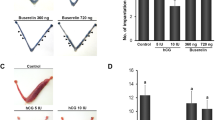Abstract
Embryo implantation is dependent on the synchronous development of the embryo and of the endometrium. Pharmacologic doses of estrogens change endometrial histology and are known to inhibit implantation. During controlled ovarian hyperstimulation, such as occurs during an in vitro fertilization cycle, serum estradiol levels may be elevated to as much as three to six times those found during spontaneous cycles. Serum progesterone levels are also increased and may counteract the elevated estradiol levels. The overall effect of ovarian stimulation on implantation is therefore not known. To study this question, we developed a mouse embryo donation model. Donor embryos were obtained in the late morula to early blastocyst stage from hyperstimulated mated mice. The donated embryos were then transferred to the uteri of two groups of recipient mice. The study group underwent ovarian hyperstimulation with pregnant mare's serum gonadotropin (PMSG) and human chorionic gonadotropin (hCG) (OHR group), while the controls were allowed to cycle spontaneously (SR group). All recipient mice underwent cervical stimulation to induce a pseudopregnant state. Five embryos were transferred to the left uterine horn of each of nine OHR mice and seven SR mice. A higher implantation rate was noted in the SR group than in the OHR group (50±12 vs 8±4%, P<0.001). Our data suggest that, in the mouse, ovarian hyperstimulation impedes implantation by causing adverse changes in uterine receptivity.
Similar content being viewed by others
References
Lopata, A: Concepts in human in vitro fertilization and embryo transfer. Fertil Steril 1983;40:289–301
Edwards RG, Steptoe PC: Current status of in vitro fertilization and implantation of human embryos. Lancet 1983;2:1265–1269
Paulson RJ, Marrs RP: Ovulation stimulation and monitoring for in vitro fertilization. Curr Prob Obstet Gynecol Fertil 1986;IX:No. 10
Jones HW, Jones GS, Andrews MC, Acosta A, Bundren C, Garcia J, Sandow B, Veeck L, Witties C, Witmger J, Worthom JE, Wright G: The program for in vitro fertilization at Norfolk. Fertil Steril 1982;38:14
Gidley-Baird AA, O'Neil C, Sinosich MF, Porter RN, Pike IL, Saunders DM: Failure of implantation in human in vitro fertilization and embryo transfer patients: The effects of altered progesterone-estrogen ratios in humans and mice. Fertil Steril 1986;45:69–74
Morris JM, van Wagenen G: Interception: The use of postovulatory estrogens to prevent implantation. Am J Obstet Gynecol 1973;115:101–106
Fossum GT, Vermesh M, Kletzky O. The role of ultrasound and estradiol levels in monitoring of spontaneous and stimulated cycles. Abstract presented at the Pacific Coast Fertility Society, Palm Springs, CA, May 6–9, 1987
Pittaway DE, Wentz SC: Evaluation of the exponential rise of serum estradiol concentrations in human menopausal gonadotropin induced cycles. Fertil Steril 1983;40:763–767
Diamond MP, Wentz AC, Herbert CM, Pittaway DE, Maxson WS, Daniel JF: One ovary or two: Difference in ovulation induction, estradiol levels, and follicular development in a program for in vitro fertilization. Fertil Steril 1984;41:524–529
DiZerega GS, Hodgen GD: Folliculogenesis in the primate ovarian cycle. Endocrine Rev 1981;2:27–49
Garcia JE, Acosta AA, Hsiu JG, Jones HW: Advanced endometrial maturation after ovulation induction with human menopausal gonadotropin/human chorionic gonadotropin for in vitro fertilization. Fertil Steril 1984;41:31–35
Hogan B, Costanfini F, Lacy E: Manipulation of the Mouse Embryo. Cold Spring Harbor, NY, Cold Spring Harbor Laboratory, 1986
Garris DR, Whitehead DS: Uterine blood flow and timing of blastocyst implantation in the guinea pig. Am J Physiol 1981;241:E142-E145
Butcher RL, Pope RS: Role of estrogens during prolonged estrous cycles of the rat on subsequent embryonic death or development. Biol Reprod 1979;21:491–495
Wilmut I, Sales DI: Effect of an asynchronous environment on embryonic development in sheep. J Reprod Fert 1981;61:179–184
Noyes RW, Dickmann F, Doyle LL, Gates AH: Ovum Transfers, Synchronous and Asynchronous in the Study of Implantation: Delayed Implantation. Chicago, University of Chicago Press, 1963
Masip A, Zualness P, Puissant F, Camus M, Leroy F: Effects of in-vitro fertilization, culture, freezing, and transfer on the ability of mouse embryos to implant and survive. J Reprod Fert 1984;71:199–204
Fiser PS, Macpherson JW: Survival of preimplantation embryos in the uteri of mice induced to superovulate and subsequently ovarectomized. J Reprod Fert 1982;64:33–36
Papaioannou VE, Ebert KM: Development of fertilized embryos transferred to oviducts of immature mice. J Reprod Fert 1986;76:603–608
Johanisson E, Parker RA, Langren BM, Diczfalusy E: Morphometric analysis of the human endometrium in relation to peripheral hormone levels. Fertil Steril 1982;38:564–571
Sundstrom P, Nilsson O, Liedholm P: Scanning electron microscopy of human preimplantation endometrium in normal and clomiphene/citrate human chorionic gonadotropin stimulated cycles. Fertil Steril 1983;40:642–647
Author information
Authors and Affiliations
Rights and permissions
About this article
Cite this article
Fossum, G.T., Davidson, A. & Paulson, R.J. Ovarian hyperstimulation inhibits embryo implantation in the mouse. J Assist Reprod Genet 6, 7–10 (1989). https://doi.org/10.1007/BF01134574
Received:
Accepted:
Issue Date:
DOI: https://doi.org/10.1007/BF01134574




